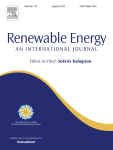Renewable energy output in sub Saharan Africa
Baye, Richmond / Albert Ahenkan / Samuel DarkwahExternal Publications (2021)
in: Renewable Energy 174, 705-714
DOI: https://doi.org/10.1016/j.renene.2021.01.144
Information
In most Sub Saharan African countries renewable energy has been part of the energy mix balance-sheet for quite a long time. However, the share of total primary energy from renewable sources have declined over time despite significant investment into the sector in the last decade. This paper pierce the veil of the energy sector to unearth the underlying factors driving renewable energy output in the region using a panel data of 32 SSA countries from 1990 to 2015. The study rely on the Driscoll-Kraay estimator to correct the problem of cross sectional dependence and serial correlation in the model. Findings from the study point to the underlying factors of renewable energy output in Co2 emissions per capita, income per capita, oil prices, trade openness, natural resource rents, urbanization, population growth rate, and climatic stress. The study proposes policies that incorporates environmental awareness in the national development plans of countries; increasing renewable energy consumption among the middle class; encourage regional renewable energy grid sharing; implementing and expanding the feed-in-tariff system; and granting tax incentives to companies that seek to invest and develop the renewable energy sector in the region.

